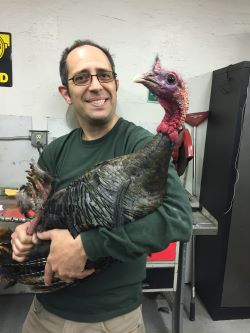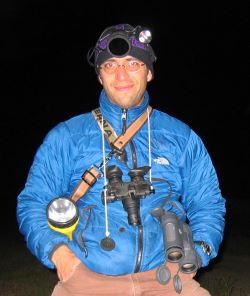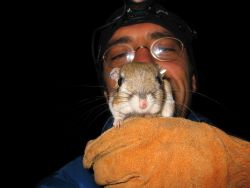
Banding wild turkeys and collecting samples in Davis .

Field work in Carrizo Plain National Monument.

Selfie with giant kangaroo rat, Elkhorn Plateau in Carrizo Plain.
Biologist Matt Meshriy assists with statewide coordination on issues affecting a broad group of species that includes upland game birds. His job also focuses on small game mammals and predators and competitors of upland game species like badgers, skunks, coyotes, and racoons. Meshriy provides support on a range of issues impacting upland game species including regulations, harvest estimates, disease surveillance, habitat assessment and grant research.
Educated at San Francisco State University, Meshriy has an undergraduate degree in ecology and evolution and a master’s degree in animal behavior and physiology with a focus in mammalogy. In 2004, he landed his first professional biology job banding spotted owls for the U.S. Forest Service in Plumas National Forest. His next professional stop was at the University of California, Berkeley, where he was a research associate in a forest pathology and mycology laboratory. There he maintained culture collections and learned to use molecular techniques like DNA extraction and amplification that later helped him in acquiring grants to fund his master’s thesis work.
Meshriy returned to San Francisco State University and taught biology laboratories and conducted field and genetic investigations of the federally endangered giant kangaroo rat in the Carrizo Plain National Monument. His thesis, titled “Kinship associations of a solitary rodent, Dipodomys ingens, at fluctuating population densities,” described behavioral adaptations of this unique species that facilitate population maintenance and dispersal under unpredictable conditions in their desert environment. After earning his graduate degree in 2009, Meshriy worked for the U.S. Geological Survey en route to being hired by CDFW in 2012.
What led you to a career in wildlife science?
First and foremost, I wanted to do something that felt meaningful. As a kid, my dad got me interested in space. He told me about the moon landings and of future missions to Mars. I grew up with Star Wars in the movie theaters. Although I was raised in the urban landscape of San Francisco and the bay Peninsula, I have always enjoyed being outside in the natural world and regularly explored the coastal mountains on my bicycle and the Sierra Nevada once I could drive.
I worked during my senior year of high school and for a year before and while attending college. I was initially interested in astronomy, astrophysics and meteorology but I came to realize that they required more math than I was comfortable with. I started looking into botany as an alternative area of study, and one semester of calculus seemed more do-able than three. As I enrolled in more elective coursework in the biological sciences, I found my way to biogeography and ecology. I’m fascinated by the relationships between organisms and I’m always curious about the ways that larger groups of organisms and systems are constantly struggling to find or maintain states of equilibrium, and how humans and our activities are increasingly affecting these systems.
Why did you apply for the upland game position?
Before applying for the position, I had very much been involved with the field aspects of data collection and processing of biological samples and data analysis. However, I didn’t have much experience or exposure to other areas of public science like policy, regulation and public outreach. When the job opening was advertised, I was leading a crew in field surveys of the federally threatened giant garter snake in the Sacramento Valley. While I enjoyed the physical work, the idea of being exposed to different aspects of wildlife management was appealing.
What’s your favorite part of your job?
In my experience, our collective progress toward solving problems and improving our understanding of issues moves forward in an uneven manner, in bits and spurts. My favorite parts of the job are the occasions when I feel connected to one of those instances of a shift to forward momentum, when new information becomes available or something new becomes possible.
This might be because a needed regulation gains enough support that it is prioritized for development, or a research need is filled through a new grant or collaboration. It’s the ability to see different facets of issues as I progress in my career. For example, how agencies work together to deliver the science that drives the policy. I like seeing how science is adapted to meet the needs of the public and how each agency and partner is involved. There’s not always a map for that process. Sometimes it takes creative thinking.
What should people know about upland game?
The term “upland game” relates to a group of species that are generally widespread in the state. Many upland game species are versatile and adaptable to a broad range of habitats whereas others occupy more specialized or geographically limited niches in California, like the rock ptarmigan and greater sage grouse.
As a group, upland game species and habitats are fairly ubiquitous in California. There are lots of opportunities for wildlife watchers and hunters alike to pursue upland game birds and mammals without having to travel too far around the state.
What advice would you have for young people interested in science careers?
Explore every opportunity that interests you. The more opportunities you can become involved with, the more likely you’ll find things that satisfy you personally and that you can make a living doing. I don’t think people should spin their wheels in internships or volunteer opportunities that don’t interest them at the outset, on the hope of landing a lucrative job that they assume will fulfil them. Instead, find the pursuits that you really enjoy and then figure out how to string together that set of knowledge, skills and experiences into something that is profitable and unique to you over time. For me, the value in casting a wide net is the broad exposure to issues and species and being able to recognize emergent properties or similarities in different areas of biology and the environment.